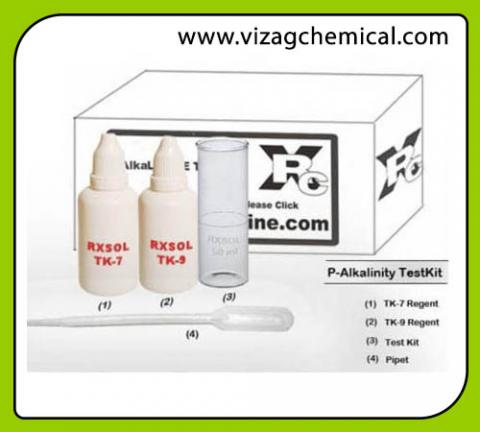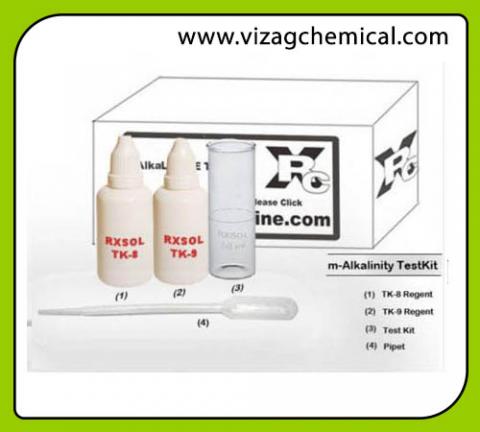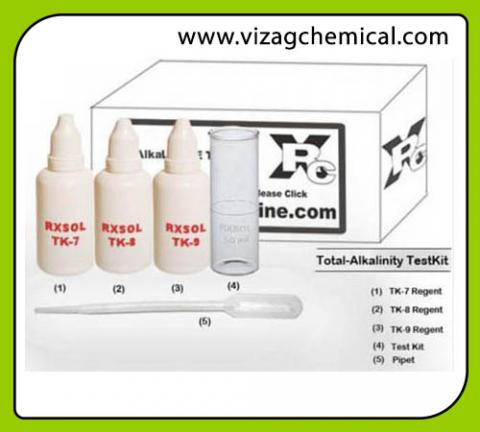Primary tabs



Alkalinity Test Kit p-m Total
The presence of alkalinity in a water sample may be due to many different substances. However, for the sake of simplicity, the presence of bicarbonate, carbonate, and hydroxide ions is commonly considered as alkalinity. The points of change in colour of phenolphthalein and methyl orange indicators, which occur at pH 8.3 and pH 4.3 provide standard reference points which are almost universally used to express alkalinity.
Very high alkalinity values can be undesirable in an industrial water supply. For example, the presence of a high methyl orange alkalinity should be avoided in boiler feed water because of the resultant carbon dioxide content of the steam. Carbon dioxide usually is responsible for the corrosion of steam and return lines. High boiler water alkalinities are also undesirable because the presence of high hydroxide ion concentration is the primary cause of caustic metal embrittlement. A very high boiler alkalinity can also lead to an undesirable carryover condition. On the other hand, the alkalinity of boiler water must be sufficiently high to protect the boiler metal against acidic corrosion and to ensure precipitation of scale forming salts. Usual treatment approaches include setting both a minimum alkalinity level and an operating range.
Hydroxide alkalinity may be determined by adding barium chloride prior to titration to precipitate the carbonate ion from solution, allowing direct titration of the hydroxide alkalinity. Measurement of hydroxide alkalinity is also used to control lime soda softeners.
In cooling water systems, alkalinity is of major importance since the total alkalinity of a water is one factor that must be considered when predicting the tendency for the water to precipitate calcium carbonate scale. Depending on the choice of chemical treatments to protect against corrosion and scale formation, the operating alkalinity and pH ranges are chosen to balance these two features.
Water Testing Procedures Manual ( Full Range ) ::: Available with us at 2700 INR or 54 US$ or 207 AED
p Alkalinity and Total Alkalinity :
Optimum Result : p-Alkalinity level is between 100 to 150 PPM is suggested.
if p-Alkalinity level is more then 150 ppm then level should be reduced by increased BLOW DOWN process with immediate effect.
For Below 50 ppm , Dose ½ Ltrs of RXSOL-50-5001-BWT for 1000 Ltrs of BOILER WATER , to maintain p-Alkalinity level 100 ppm.
:::::::::::::::::::::Alkalinity TEST FOR BOILER & COOLING WATER ::::::::::::::::::::::::
| REAGENT & APPARATUS | |
| Reagent: RXSOL TK 7 , TK 8 , TK 9 , . Apparatus : TEST TUBE , Titrator or DROPPER | |
| A.) PROCEDURE for p-ALKALINITY test ( STEP WISE ) | |
| 1 |
Measure 10 ml of SAMPLE WATER in graduated TEST TUBE / CYLINDER |
| 2 |
Add 1-2 drops of RXSOL TK7 and mix with the stirring rod , If sample turns red / PINK ( which indicates presence of p-Alkalinity ) then follows 3rd step otherwise if sample remains colourless ( Record p-Alkalinity = 0 ) . |
| 3 |
Add RXSOL TK9 drop by drop ( by counting ) , mixing with the stirring rod until colour just disappears. Each drop is equivalent to 25 ppm of p-Alkalinity , expressed as CaCO3 |
| RESULT | Each DROPS is equivalent to 25 PPM of p-Alkalinity. |
| NOTE | p-Alkalinity VALUE = 25 X ( Total Number of DROPS of TK9 , during 3rdstep ) |
|
|
|
| C.) PROCEDURE for TOTAL ALKALINITY ( VALUE of A + VALUE of B ) | |
| 2.1 |
Measure 10 ml of SAMPLE WATER in graduated TEST TUBE / CYLINDER |
| 2.2 |
Add 1-2 drops of RXSOL TK7 and mix with the stirring rod , If sample turns red / PINK ( which indicates presence of p-Alkalinity ) then follows 3rd step otherwise if sample remains colourless ( Record p-Alkalinity = 0 ) then proceed to STEP- 4. |
| 2.3 |
Add RXSOL TK9 drop by drop ( by counting ) , mixing with the stirring rod until colour just disappears. Each drop is equivalent to 15 ppm of p-Alkalinity , expressed as CaCO3 |
| 2.4 | Add 2-3 drops of RXSOL TK8 and mix with stirring rod , the sample will turn to BLUISH-GREEN . |
| 2.5 |
AddRXSOL TK9 carefully by counting drop by drop and mixing throughly until a light reddish ( salmon ) pink colour develop. |
| RESULT | Each DROPS is equivalent to 25 PPM of Alkalinity |
| NOTE |
p-Alkalinity ppm CaCO3VALUE = 25 X ( Total Number of DROPS of TK9 , during 2.3 step ) = X ( Say ) |
alkalinity test method , alkalinity method, alkalinity test procedure, alkalinity titrator chemicals, water alkalinity test kit
alkalinity test kit for boiler water and cooling water, alkalinity test kit instructions
Optimum Result : p-Alkalinity level is between 100 to 150 PPM is suggested. if p-Alkalinity level is more then 150 ppm then level should be reduced by increased BLOW DOWN process with immediate effect. For Below 50 ppm , Dose ½ Ltrs of RXSOL-50-5001-BWT for 1000 Ltrs of BOILER WATER , to maintain p-Alkalinity level 100 ppm. Refill pack : REPLACEMENTS TK7 : ECONOMIC PACK ( 100 / 200 / 500 ml ) available TK8 : ECONOMIC PACK ( 100 / 200 / 500 ml ) available TK9 : ECONOMIC PACK ( 100 / 200 / 500 ml ) available |
total alkalinity test kit manufacturer, Exporter and supplier in mumbai, kandla, Gandhidham, chennai, Ennore, Kolkata, Kakinada, Vizag, Manglore, Goa, Tuticorin, Fujairah, Dubai, Sharjah, Uae, Middle East
OFFER :::---
Do not forget to ask JUMBO PACK OFFER ( TK - extra pack )
Ask for FREE TK extra pack
Avoid contact with EYE / Hand and other CHEMICALS and Gases.
For determination of Hydroxide alkalinity only, barium chloride is added prior to titration to precipitate the carbonate ions. Titration is then taken only to the phenolphthalein end point. A pH meter may be used instead of the indicators to determine the end points of the titration.
